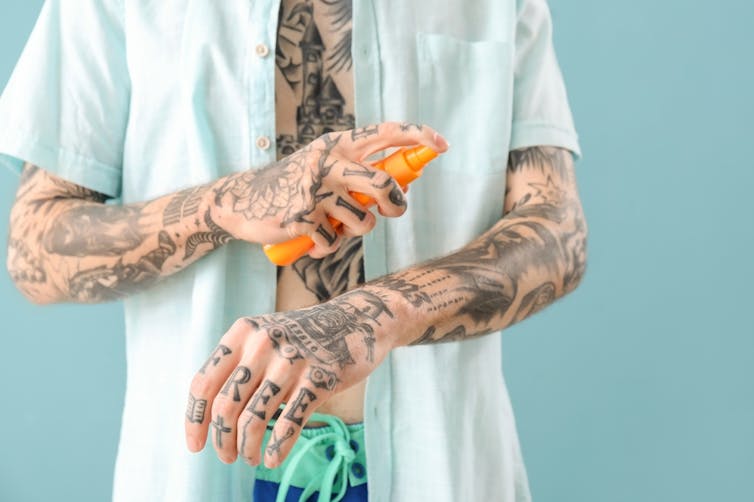More of us have tattoos than ever before. About 25% of Australians are inked.
A tattoo can be a large investment in time, money and pain.
So how do you take care of your tattooed skin? Here’s what you need to know about sunburn, sweating and fading.
Read more: Tattoos have a long history going back to the ancient world – and also to colonialism
What’s a tattoo, dermatologically speaking?
Tattoo inks are deposited in the layer of skin called the dermis. This layer contains sweat and oil glands, a blood supply, immune cells, collagen to support the skin’s structures, and fibroblasts, which produce collagen.

Fibroblasts take up the ink particles, as do immune cells in the dermal tissue known as macrophages. The ink particles also stick inside bundles of collagen.
Between these three mechanisms, the dermis holds tattoo inks so well they can be seen even on the 5,300-year-old ice mummy Ötzi.
Can I get a tattoo if I’m sunburnt?
No, and many tattoo artists will not do it. During sunburn, your skin calls in extra immune cells and fluid to kill off and break down cells that have too much UV damage.
This inflammation can affect the tattoo ink deposits. You might not get the look you were after, with too much ink removed by your immune cells or swelling distorting the lines.
It’s much better to be proactive about sun protection before a tattoo, or at least be patient and reschedule when your skin has healed.
Read more: I can't get sunburnt through glass, shade or in water, right? 5 common sunburn myths busted
How soon after my new tattoo can I go into the sun?
There’s not much research on how soon you can expose your new tattoo to the sun. However, most tattooists advise you to avoid sun exposure while the tattoo heals, generally about three weeks.
This seems sensible, as your fresh tattoo is a type of wound.

Because the skin is damaged by inserting a needle, it’s not too surprising that the most common short-term complication is local inflammation with swelling, redness and discomfort at the tattoo site. There is an influx of immune cells to deal with the damage, much like a sunburn.
So, in one way, you should treat your new tattoo like sunburn and avoid sun exposure while it heals.
But you shouldn’t use sunscreen on the tattoo in that time. That’s because sunscreen can enter the dermis through the puncture wounds and cause more irritation. Cover your new tattoo with loose clothing instead.
Read more: Do beach cabanas actually protect you from the sun?
What happens if my tattoo gets sunburnt?
Sunlight-induced reactions to both new and existing tattoos are common. There’s usually swelling, itching or stinging on the tattoo site that can start immediately or develop over the course of a day. We’re not really sure why this happens.
Most of the time, these reactions are unpleasant but don’t require medical treatment, much like sunburn.
There is also a small amount of evidence that sunburn on a tattoo temporarily suppresses the skin’s immune system, allowing an infection to become established.
Read more: Common skin rashes and what to do about them
Do tattoos increase my risk of skin cancer?
Some ink components, such as mercury or carbon black, are suspected cancer-causing agents when used in other applications. However, there’s no evidence skin cancers are more likely in tattooed skin.
Tattoos make newly-developed skin cancers more difficult to detect. Besides making the lesion more difficult to spot in the first place, the colours of the tattoo interfere with your doctor’s assessment of the colours in the lesion, which can be an important sign of cancer.
So it’s a good idea to get familiar with the moles and freckles on a patch of skin before you’re inked, and check them yourself once a month for changes.

Red tattoos seem to be more prone to large but benign (non-cancerous) skin tumours called keratoacanthomas. These appear within a few months of tattooing, and often grow rapidly but then heal by themselves.
However, they can be difficult to distinguish from squamous cell carcinomas (a type of skin cancer). They can also damage underlying structures, such as nerves and muscles. So they often need to be removed anyway.
Read more: Health Check: do I need a skin cancer check?
Can sunlight fade my tattoo?
As tattoos age, they can fade a bit as some of the loose ink particles filter deeper into the dermis. Sun exposure can also degrade ink particles.
There’s limited research on this in human skin. After all, most people don’t want to fade their tattoos for science. So most of what we know is from research in mice.
However, modern tattoo inks give you a strong colour. So in practice, you might not notice any fading for years.
Read more: Friday essay: power, perils and rites of passage – the history of the female tattoo
Does tattooed skin sweat differently to un-inked skin?
This is an important question, because sweating is a major way our body avoids overheating in the summer. If you’ve got a full sleeve or your whole back is your canvas, that’s a significant amount of skin.
Since tattooing punctures the skin repeatedly, sweat glands in the dermis may be damaged.
But the research on tattoos’ impact on sweating is mixed and depends on what you are doing at the time.
In one study, researchers used a heatable suit to increase study participants’ internal body temperature by 1°C. Tattooed areas produced about 15% less sweat. It’s not clear if this is enough to increase the risk of heat stress.
However, when other researchers looked at sweating induced by exercise there was no effect in the volume of sweat between tattooed and un-tattooed skin.
Read more: How tattoos became fashionable in Victorian England
Longer-term risks
When performed under the clean conditions of a licenced tattoo parlour, tattooing is relatively safe.
But long term, some people develop allergic reactions to certain colours due to the different compounds in each, most commonly red dyes. This can cause lumps, scales, scarring or other visible changes.
So, what’s the most common long-term side effect of tattoos? Tattoo regret and wanting to have them removed.
Katie Lee receives funding from the National Health and Medical Research Council.
Erin McMeniman does not work for, consult, own shares in or receive funding from any company or organisation that would benefit from this article, and has disclosed no relevant affiliations beyond their academic appointment.
This article was originally published on The Conversation. Read the original article.







